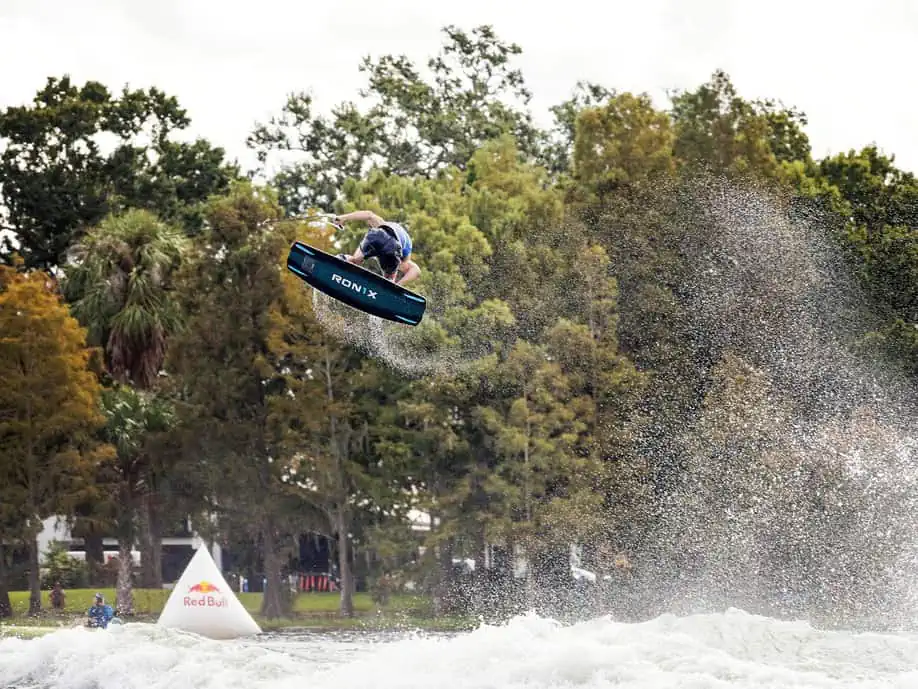
15 Nov Thomas Herman Triple Effect | Ronix Wakeboards
Thomas Herman , how push wakeboarding at the next level !
Thomas Herman : Progression stands out as arguably the most crucial element in the realm of wakeboarding. It manifests through the accomplishment of new tricks or the infusion of a distinctive flair into existing maneuvers. Both avenues hold the potential to unlock a cascade of ideas and developments that evolve over time. Occasionally, there are those extraordinary, monumental leaps in progression that etch themselves into the wakeboarding history books, creating moments indelibly etched in the minds of wakeboarding enthusiasts.
In a contest format dedicated to pushing the boundaries of wakeboarding possibilities, a groundbreaking chapter was written at the Red Bull Double or Nothing on a lake in downtown Orlando.
During the early days of wakeboarding, the double up served to provide riders with extended airtime, allowing for additional 180-degree spins or the incorporation of grabs into tricks that were otherwise hurried off the small wakes generated by boats at that time. Inboard competition boats, originally designed as slalom ski boats to create minimal wakes for speeds exceeding 30 mph, offered wakeboarders and trick skiers lift at slower speeds of 18 to 20 mph. As the pioneers of wakeboarding realized the potential of timing a roller created while turning around to coincide with the boat wake, the sport witnessed an influx of new tricks.
Boats continued to grow in size and weight, with engines, transmissions, and propellers pushing more weight, displacing more water, and causing wakes to consistently enlarge. Eventually, the double up ceased to be a necessity for progression. In fact, many riders began avoiding regular double up attempts since the wakes had become substantial enough to learn new tricks without it, mitigating the looming fear of injury. It’s a safe assumption that the majority of injuries at the professional level over the last three decades occurred during double up attempts.
Thomas Herman make the History
While the wake directly behind the boat offers a predictable and consistent pop, the double up introduces a high level of unpredictability, relying heavily on the driver to create a stable set-roller and approach at an optimal angle. What makes the double up even more unique is that each rider tends to prefer something a little different. Some riders like the angle “T-ed up” or prefer a closer-to-90-degree approach, while others lean towards a more “open” or easier pocket to enter. Even in ideal conditions, the double up remains a volatile element, producing a stunt-like kick that is challenging to control.
Regarded as the GOAT (Greatest of All Time), Parks Bonifay utilized the double up to elevate himself to legendary status throughout his illustrious career. It’s fitting that this event was conceived by Parks and Red Bull, providing riders with the motivation to refocus on the double up and push the boundaries of progression in a winner-takes-all format. The inaugural event took place in 2004 and was an instant success. Although the event took a hiatus for a few years, it has maintained its exclusivity by only including riders that Parks deems worthy, with the added opportunity for riders to earn a wildcard. This year, rookies Jamie Huser and snowboard cross-over athlete Fynn Bullock seized that chance.
More About Ronix #unleashedwakemag
Thomas Herman Triple Effect
The breaking of the triple flip barrier has propelled the upcoming Double or Nothing into the limelight, guaranteeing unprecedented attention. Speculation is rife on the types of tricks that will be attempted in the coming year.
Find all wake spots around the world on]



